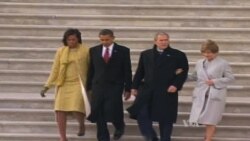During an election year, the spotlight is on the presidential candidates, their platforms and their campaigns. But months before the election, behind the scenes, the massive job of preparing for the presidential transition begins.
Transition of power in the United States is both the working of a sophisticated democracy and a technical feat to ensure there is no gap in governing, following presidential elections.
“The whole idea of the transition is to maintain that stability, while you change to the policy direction of the winning candidate,” says Stephen Wayne, a professor of government at Georgetown University and an expert on the presidency.
Complex process
Transition takes place in the White House, within the campaigns, but also in the various agencies.
For this election, Democratic candidate Hillary Clinton’s team is led by former Secretary of the Interior Ken Salazar; Republican rival Donald Trump’s is led by New Jersey Governor Chris Christie.
Both teams work at a government facility on 1717 Pennsylvania Avenue, very close to the White House, and a budget has been allocated for the process. The day after the election, transition begins in earnest between the winning candidate’s and the outgoing administration’s teams.
David Eagles, director of the Center for Presidential Transition at the Partnership for Public Service, says his center is helping the candidates’ teams be ready to govern from day one, should they win.
“Presidential transitions have always been big and complex and a period of vulnerability for the country, but we feel when managed strategically, it provides one of the greatest opportunities to make government more effective,” Eagles says.
Transition teams gather information, sift names for cabinet posts and other political positions in the new administration, and coordinate with the incumbent president’s staff. The first transition meeting at the White House took place in August.
“This meeting of the White House Transition Coordinating Council was focused on the kinds of steps along the way that the federal government and that the representatives of the two candidates will have to take over the course of the next five months as they eventually prepare for one of them to become president of the United States,“ said White House spokesman Josh Earnest after that initial meeting.
Immune from campaign rhetoric
No matter how divisive the campaign is – and by almost every account, this year’s campaign has been particularly harsh – the transition process has been designed in such a way that the rhetoric of the campaign does not – or should not - affect it.
“The best practice here is that the transition apparatus, the governing apparatus, is completely separate than the campaigning and the willingness to win apparatus,” Eagles says.
Because, as professor Wayne puts it, “Elections divide, but after the elections you have to come together. And the government still operates; people still demand services. They want visas. They want the military to protect them. They want loans if they get them and guaranteed, so you can’t say, ‘I am sorry, this is very complex.’ ”
Eagles says candidates need to understand that governing is different from campaigning, and you have to plan early.
“If you are not thinking about those things early, you’ll be one year, two years, into your administration before you even have these people in place, and the American public will not stand for that. And we shouldn’t as the public, stand for that,” he says.
Continuity
But it is not only a matter of being ready to carry out your duties. A smooth transition means that the institutional structure of the country is sound.
“It’s very important if you love your country and you love your constitutional system to protect it and not to upset it, and we don’t have autocratic government in the United States, and I think we want to prevent that. So helping the new people take over even if you didn’t like them, even if you didn’t vote for them is very, very important, ” Wayne says.
In his view, the best transition has been from former President George W. Bush, a Republican, to President Barack Obama, a Democrat.
In a sign of how continuity transcends political divisions, Earnest says President Obama and his team at the White House benefited tremendously from the effectiveness of that transition.
“I think it did reflect a commitment to professionalism and democracy that President Obama and his team is determined to live up to," he says.
Although some form of transition of power has been carried out for over 200 years, it was only in 1963 – during the Kennedy administration – that Congress enacted the Transition Act, to provide money for the next transition.
With the Kennedy assassination and Lyndon Baines Johnson taking over and subsequently winning the election, the first formal transition did not happen until 1968 when Richard Nixon became president.






























